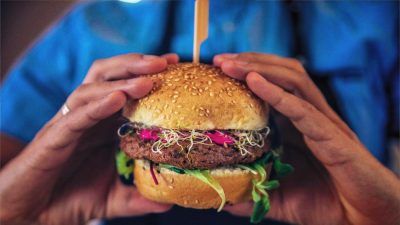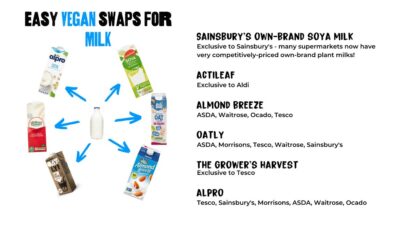Lactose intolerance and cow’s milk allergy – not to be confused!

Lactose intolerance and cow’s milk allergy are often confused because they both involve reactions to milk, but they are very distinct conditions. Lactose intolerance is a digestive issue related to the inability to digest the sugar lactose, whereas cow’s milk allergy is an immune response to the proteins in cow’s milk.
Lactose Intolerance
After returning from the Beagle expedition in 1836, Charles Darwin wrote: “I have had a bad spell. Vomiting every day for eleven days, and some days after every meal”.
Darwin struggled for over 40 years with long bouts of vomiting, stomach cramps, headaches, severe tiredness, skin problems and depression. Many researchers now think that he had lactose intolerance and his case is a good example of how easily it can be missed or misdiagnosed.
Lactose is the sugar in mammals’ milk and in order to release its energy, it must be broken down into its constituent simple sugars – glucose and galactose – so they can be absorbed. This task falls to an enzyme called lactase, produced by cells lining our small intestines
If your body doesn’t produce this enzyme, then lactose travels to the large intestine, where it is fermented by gut bacteria, producing hydrogen and a range of potential toxins. This is ‘lactose intolerance’ and most symptoms result from the production of gases and toxins by these gut bacteria. Symptoms include a bloated and painful stomach, wind, diarrhoea and, on some occasions, nausea and vomiting.
Other symptoms can include muscle and joint pain, headaches, dizziness, lethargy, difficulty with short-term memory, mouth ulcers, allergies, irregular heartbeat, sore throat, increased need to pass urine, acne and depression.
Even more worrying is that when lactose is not properly digested and passes into the colon, where bacteria ferment it, they can produce various toxins which may play a key role in the onset or progression of diseases such as diabetes, rheumatoid arthritis, multiple sclerosis and some cancers.
Everyone naturally produces lactase when they are babies – without it we couldn’t drink our mother’s milk. However, all mammals and the vast majority of people stop producing it soon after weaning – for us, around the age of two. This is the normal state for most people – around 70 per cent of the world’s population, in fact.
In Northern Central Europe, lactose intolerance affects between two and 20 per cent of people, rising to 40 per cent in Mediterranean countries – most common in Italy, where it affects 56 to 70 per cent in some regions. Highest rates are seen in Africa, where it affects 65 to 75 per cent of people, and in many parts of Asia, more than 90 per cent of people are lactose intolerant.
So why are some people able to digest lactose after weaning and others not? ‘Lactase persistence’ originates from a genetic mutation that occurred among a small number of European and African pastoral tribes within the last 5,000 to 10,000 years – in evolutionary terms, this is very recent history. It provided a selective advantage to populations using dairy products, enabling them to live long enough to have children. The average life expectancy was probably little more than 25 years, but this meant the ability to digest lactose could be passed on to subsequent generations. Descendants of these people can still consume cow’s milk without suffering the symptoms of lactose intolerance. It doesn’t mean, however, that it’s good for them!
The best treatment for lactose intolerance is straightforward: avoid lactose. That means cutting out all cow’s milk and dairy products and checking ingredients to avoid them as lactose is added to many unlikely foods often as part of milk, milk powder, whey or other milk-derived ingredients. These foods may not taste ‘milky’ but can still contain significant amounts of lactose, including some breads, breakfast cereals, salad cream, mayonnaise, biscuits, chocolate, cake, crisps, instant soup and even some processed meats, such as sliced ham and hot dogs. The word ‘lactose’ will not necessarily be listed on food labels so look out for things like dried milk or whey powder.
Lactose is also used as a filler in many types of medication and while this may not trigger symptoms in most people with lactose intolerance, it can cause problems in some. Check with your doctor and request lactose-free tablets.
Cow’s milk allergy
Cow’s milk allergy is very different to lactose intolerance. An allergic reaction is when the body’s immune system launches an inappropriate response to substances mistakenly perceived as a threat. Common triggers include latex, detergent, dust, pollen or certain proteins in food. In cow’s milk, it is mainly the protein casein that causes most problems but whey protein can also trigger a reaction in some.
General symptoms include inflammation, sneezing, runny nose, itchy eyes and so on, giving rise to the classic allergies – asthma, eczema, hay fever and urticaria (skin rash or hives). Because cow’s milk allergy is linked to many conditions – including asthma and eczema – it’s always useful to consider it when treating them.
Cow’s milk allergy is one of the most common food allergies in children, estimated to affect up to 7.5 per cent of infants under one, although some grow out of it by the age of five. Symptoms include an itchy rash or swelling, stomachache, vomiting, colic, diarrhoea or constipation and a runny nose. Symptoms can appear almost immediately or up to 72 hours after consuming cow’s milk protein. This makes it difficult to diagnose.
Gastrointestinal bleeding is a recognised but uncommon symptom among infants with cow’s milk allergy. In those who do experience it, blood loss may occur in such small quantities that it goes unnoticed but in rare cases can contribute to iron-deficiency anaemia. However, among infants diagnosed with cow’s milk allergy, gastrointestinal bleeding only occurs in a minority of cases and is generally less common than other symptoms like skin reactions, vomiting and/or diarrhoea.
Cow’s milk contains virtually no iron but does contain potent inhibitors (mainly casein and calcium) that can reduce iron absorption from other foods in the diet. The high protein, sodium, potassium, phosphorus and chloride content of cow’s milk presents what is called a ‘high renal solute load’. Unabsorbed solutes from the diet must be excreted by the kidneys and this can place a strain on immature kidneys, forcing them to draw water from the body thus increasing the risk of dehydration. This is why most health bodies say that off-the-shelf cow’s milk should not be given to children under 12 months of age.
Although most food allergies start in childhood, you can develop them as an adult, too. Cow’s milk allergy in adults is relatively rare but symptoms tend to be much more severe than in children when they do occur, with reactions being triggered by amounts as low as 0.3 milligrams of cow’s milk protein.
The most severe type of allergic reaction (anaphylactic shock) may involve difficulty in breathing, a drop in blood pressure and ultimately heart failure and death. Occasionally, cow’s milk allergy can cause severe symptoms that come on suddenly, such as swelling in the mouth or throat, wheezing, coughing, shortness of breath and difficulty breathing. In such cases, immediate medical help must be sought.
The only reliable treatment for cow’s milk allergy is to avoid all cow’s milk and dairy products, including milk, milk powder, milky drinks, cheese, butter, margarine, yoghurt, cream and ice cream. Products with hidden milk content should also be avoided – look out for: casein, caseinates, hydrolysed casein, skimmed milk, skimmed milk powder, milk solids, non-fat milk, whey and milk solids.
People with cow’s milk allergy face a similar problem as those avoiding lactose – milk-based ingredients can be difficult to avoid as they are commonly used in the production of so many processed foods. It can seem a daunting prospect, having to read the ingredients labels but most supermarkets now have a ‘free-from’ section and many have their own-label range. There are also apps available to help you identify ingredients by scanning product barcodes. Of course, there are now also a huge number of dairy-free alternatives to choose from such as vegan milks, cheeses, cream, yoghurt and more to choose from.
It’s a myth that people who avoid dairy miss out on calcium – there are many excellent non-dairy sources, including green leafy vegetables (spinach is a relatively poor source as it contains oxalate which binds calcium), dried fruits, nuts and seeds, calcium-set tofu and calcium-fortified soya milk. Remember, 70 per cent of the world’s population don’t do dairy – so you’re not alone!
Dairy consumption in the UK is in decline as the market for plant-based milks, vegan cheese, yoghurt and other alternatives is booming. Whether you are lactose intolerant, allergic to cow’s milk protein or simply want to cut out dairy for health reasons, the animals or the environment, there’s never been a better time to go dairy-free.
Going vegan has never been easier, there are vegan foods labelled as such in every major supermarket. Find out how easy it is here: www.viva.org.uk/easyvegan







